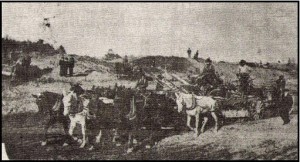What Happened to the Proposed WALSH Railroad in Clay County 100 Years Ago?
“On September 10, 1886, D. C. J. McKAY, president of the Evansville and Terre Haute Railroad incorporated the Evansville and Richmond Railroad. The E&R was to run from a junction with the E&TH at Elnora east to Richmond, IN…..In 1897, under foreclosure, the E&R was sold to a group headed by John R. WALSH, an Irish immigrant whose parents had settled in Chicago. He sold newspapers, served as a theater usher, and by 1865 was a serious rival of the American News Co. He and Andrew McNALLY founded the Western News Co. and WALSH was soon a rich man.
WALSH had three ambitions: to own a newspaper, a band and a railroad. He established Chicago National Bank in 1881 and bought the Chicago Herald later that year. Later, he started the Home Savings Bank and the Equitable Trust Co.….In 1897 WALSH bought the E&R to realize his third ambition, and changed the name to the Southern Indiana Railroad.…WALSH extended the line from Elnora through the Greene-Sullivan coalfields and Linton to Terre Haute. The line was opened in 1900. …Officials of the railroad were (John) WALSH, president; James WALSH, vice president; C.F. WEINLAND, auditor; L.A. WALTON, treasurer; H.H. ROSEMAN, general agent; J.W.THOMPSON, superintendent; and E. S. WALKER, master mechanic.…WALSH’s empire started to crumble in 1905 with the three Chicago banks failing. Early in 1906 the federal government charged him with mis-use of depositors’ funds. Two years later, the railroads entered receivership and WALSH at the age of 70 was sentenced to five years in Leavenworth. In 1910, the Chicago Terre Haute and Southeastern Railway was chartered to operate both the SI and CS which had been sold at foreclosure earlier…”
The foregoing information. was excerpted with permission from the History of the Evansville Indianapolis and Terre Haute Railroad by Kenneth L. & Mary Lou REED.
“WALSH’s Best Road in Receiver’s Hands: Alleged at Convicted Banker’s Trial That he Drained Funds of His Banks to Develop Railroads”
The following information appeared The New York Times, August 21, 1909: “Federal jurisdiction now extends over the Southern Indiana Railway Company through the appointment of a receiver in the United States Circuit Court. The road has long been regarded as the best of what are known as the John R. WALSH Railroads. On a petition presented by counsel for the First Trust and Savings Bank of Chicago, the representatives of the Chicago Clearing House Association, Judge Christian C. KOHISAAT late last night appointed M. J. CARPENTER, formerly President of the Chicago & Eastern Illinois Railway Company, receiver of the Southern Indiana Railway Company.
Failure to meet the interest on the bonded indebtedness of the road was the proximate cause of the petition for court action. For months there have been rumors that a receivership was the only solution of the financial difficulties of the road, which were actuated by industrial depression that made it difficult to pay operating expenses.
The Southern Indiana Road was the first railroad acquired by John R. WALSH in the extending of his banking business from banking lines to a wider financial field; the methods employed to develop the road and finance the other railroad enterprises formed a large part of the trial which preceded the conviction of the aged banker on a charge of misapplying funds of the Chicago National Bank, of which he had been president.…One of the strong points made by the government attorneys in their arguments before the jury, which convicted the former banker, was that the Chicago National Bank and the Home Savings Bank, as well as the Equitable Trust Company, which were practically controlled by John R. WALSH, had been drained of funds to supply money with which to develop the railways. Mr. WALSH, on the witness stand, declared his belief that the roads were good business propositions, and that his judgment in investing money in them would be supported…The claim of the First Trust and Savings Bank, complainant in the receivership proceedings, amounts to $135,000, on two promissory notes. Interest on these notes and the notes themselves are past due, and the defendant company admits its inability to pay.”

Pictured to the right is a section of the grade work on the east side of the river directly north of Bowling Green. Horses and mules were used to do the work of plowing and pulling the dirt conveyer, which filled the dump wagons as they drove alongside.
In 1903 the contract was let to begin building the WALSH Railroad across Clay County. Work began on a large scale the following year. In the late summer of 1905 most of the grade work was completed from Blackhawk, Indiana, east to Eel River at Bowling Green.
He planned to build a railroad from Blackhawk to Indianapolis. Work was stopped on December 25, 1905, after spending $447,714. When America entered a recession in 1907, WALSH discovered he had stretched himself too thin. Two of his banks failed, and WALSH was charged with 180 violations of federal banking laws. Walsh was defended by Terre Haute attorney, Samuel R. HAMILL.
Although, HAMILL’s arguments were persuasive, on Jan. 18, 1908, a Chicago jury found WALSH guilty of 54 of the 180 counts of misapplication of bank funds. He was sentenced to five years at Leavenworth penitentiary.
Attorney HAMILL worked endless hours on the case, and contracted pneumonia during that time; he died on Jan 24, 1908, barely a month after his 50th birthday.
The Southern Indiana went into receivership in November 1910 and was reorganized as the Chicago, Terre Haute & Southeastern Railroad. That railroad became part of the Milwaukee Road in the early 1920s.
